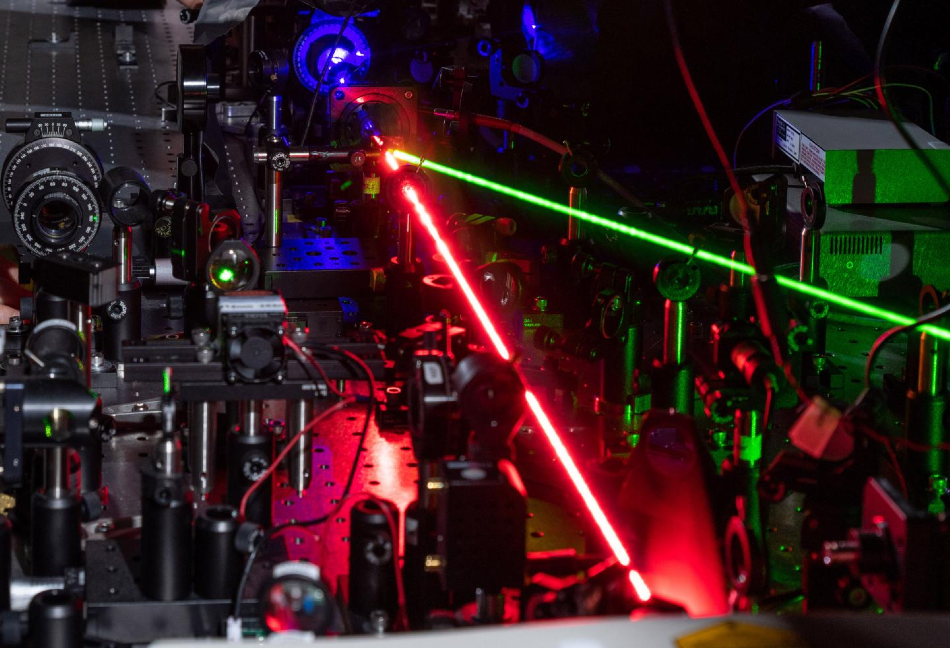Jan 7 2020
A new all-optical method has been demonstrated by researchers for producing strong second-order nonlinear effects in materials that do not support them usually.
 A red laser creates nonlinear effects with tiny triangles of gold. The blue beam shows the frequency-doubled light and the green beam controls the hot-electron migration. Image Credit: Rob Felt, Georgia Tech.
A red laser creates nonlinear effects with tiny triangles of gold. The blue beam shows the frequency-doubled light and the green beam controls the hot-electron migration. Image Credit: Rob Felt, Georgia Tech.
The scientists successfully produced excited electrons by utilizing a laser pulse fired at a series of gold triangles on a titanium dioxide (TiO2) slab. These excited electrons increased the frequency of a beam by twofold; this beam emerged from a second laser as it projected off the amorphous TiO2 slab.
By extending the range of optical materials essential for microscale and nanoscale optoelectronic applications, the study can provide new possibilities to optical engineers producing second-order nonlinear effects. Such effects are crucial in many areas such as high-speed data processors, optical computers, and bioimaging, safe for use in the human body.
Now that we can optically break the crystalline symmetry of traditionally linear materials such as amorphous titanium dioxide, a much wider range of optical materials can be adopted in the mainstream of micro- and nanotechnology applications such as high-speed optical data processors.
Wenshan Cai, Professor, School of Electrical and Computer Engineering, Georgia Institute of Technology
The proof-of-concept results were published in the Physical Review Letters journal on January 2nd, 2020. The study was funded by the National Science Foundation, the U.S. Department of Energy Office of Science, and the Office of Naval Research.
A symmetric crystal structure is exhibited by most optical materials. This structure restricts their potential to produce second-order nonlinear effects—for example, frequency doubling—that fund crucial technological applications. To date, this symmetry can only be disturbed when mechanical strain or electrical signals are applied to the crystal.
Cai and colleagues Mohammad Taghinejad, Zihao Xu, Kyu-Tae Lee, and Tianquan Lian produced a series of small plasmonic gold triangles on a centrosymmetric TiO2 slab surface in the laboratory.
Using a pulse of red laser light, the researchers successfully illuminated the TiO2/gold structure. This laser light served as an optical switch for breaking the material’s crystal symmetry. Naturally, the amorphous TiO2 slab would fail to support the powerful second-order nonlinear effects.
The optical switch excites high-energy electrons inside the gold triangles, and some of the electrons migrate to the titanium dioxide from the triangles’ tips. Since the migration of electrons to the TiO2 slab primarily happens at the tips of triangles, the electron migration is spatially an asymmetric process, fleetingly breaking the titanium dioxide crystal symmetry in an optical fashion.
Wenshan Cai, Professor, School of Electrical and Computer Engineering, Georgia Institute of Technology
Upon triggering the red laser pulse, the induced symmetry breaking effect is visualized almost immediately. This phenomenon increased the frequency of a second laser by twofold; the laser being subsequently bounced off the TiO2 comprising the excited electrons.
Normally, the lifespan of the induced second-order nonlinearity relies primarily on electrons quickly moving back from TiO2 to the gold triangles, after the pulse disappears.
The scientists reported a case study in which the induced nonlinear effect lasted only for a few picoseconds. According to the researchers, this duration is sufficient for a majority of applications where short pulses are utilized. As long as the laser is on, the effect can be prolonged by using a consistent continuous wave laser.
Cai added, “The strength of the induced nonlinear response strongly depends on the number of electrons that can migrate from gold triangles to the titanium dioxide slab. We can control the number of migrated electrons through the intensity of the red laser light. Increasing the intensity of the optical switch generates more electrons inside the gold triangles, and therefore sends more electrons into the TiO2 slab.”
More research is required to further develop the proof of concept, which for the first time demonstrated that it is possible to break the crystal symmetry of centrosymmetric materials by optical means, through asymmetric electron migrations.
“To approach the practical criteria detailed on the essence of our technique, we still need to develop guidelines that tell us what combination of metal/semiconductor material platform should be used, what shape and dimension would maximize the strength of the induced second-order nonlinear effect, and what range of laser wavelength should be used for the switching light,” Cai observed.
One potential application for the technique is frequency doubling, he stated.
“We believe that our findings not only provide varieties of opportunities in the field of nonlinear nanophotonics, but also will play a major role in the field of quantum electron tunneling,” Cai further added.
Indeed, built upon the accumulated knowledge in this field, our group is devising new paradigms to employ the introduced symmetry breaking technique as an optical probe for monitoring the quantum tunneling of electrons in hybrid material platforms.
Wenshan Cai, Professor, School of Electrical and Computer Engineering, Georgia Institute of Technology
“Nowadays, achieving this challenging goal is only possible with scanning tunneling microscopy (STM) techniques, which are very slow and show low yield and sensitivity,” concluded Cai.